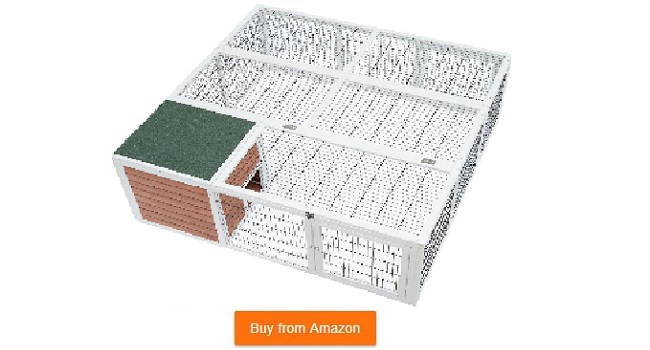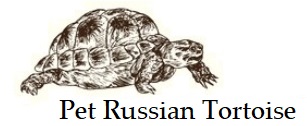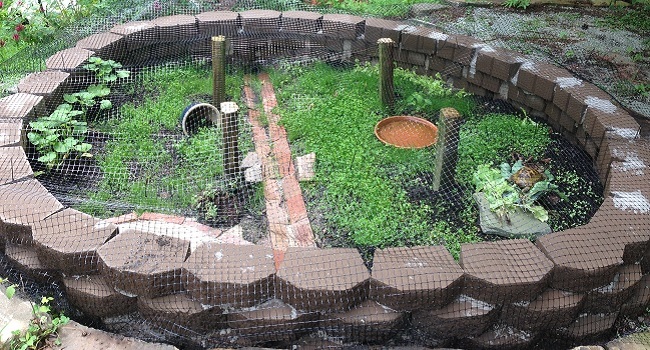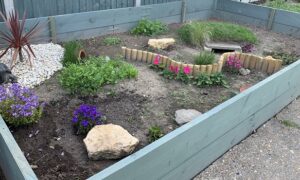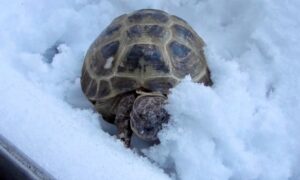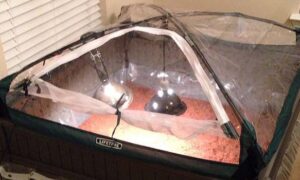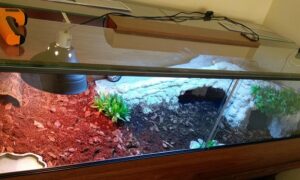You can leave a Russian tortoise inside year round. However, time outside is ideal for natural UV rays and exercise. UV rays help tortoises produce D3 to properly absorb calcium and other nutrients. But when putting your Russian tortoise outside, you need to ensure the enclosure is safe. Creating a safe outdoor enclosure for baby Russian tortoise is relatively simple.
Baby Russian tortoises are small, averaging a few inches long, depending on age. It’s very important to have a save outdoor enclosure for a baby Russian tortoise. You can easily lose a small baby tortoise. Predators may enjoy a tasty snack. The tortoise can escape tiny holes and gaps.
How Much Time Should a Baby Russian Spend Outside?
In an indoor enclosure, you need to use a UV bulb or a UV tube, but if you’re able to put the baby Russian tortoise outside, you reduce, if not eliminate the need for artificial UV light in an inside enclosure.
The minimum time a baby Russian tortoise should be outside is about one hour per one inch of length. Avoid the hottest time of the day because baby tortoises can easily overheat.
Try to put the tortoise outside a few times a week, making sure when outside, the enclosure is safe and the tortoise is protected.
Set Up an Outdoor Enclosure for a Baby Russian Tortoise
When setting up a safe outdoor enclosure for a baby tortoise, you don’t need much. The outdoor enclosure does not need to be elaborate or fancy.
Setting up an Outdoor Enclosure for a Baby Tortoise
Make sure that the enclosure is safe from predators and safe for your tortoise.
You need secure walls that will prevent the tortoise from pushing out of the enclosure. A determined baby tortoise can push materials around just enough to make a gap to escape. You need a secure lid to prevent a predator from taking the baby tortoise out of the enclosure. You also want to make sure the tortoise cannot dig out.
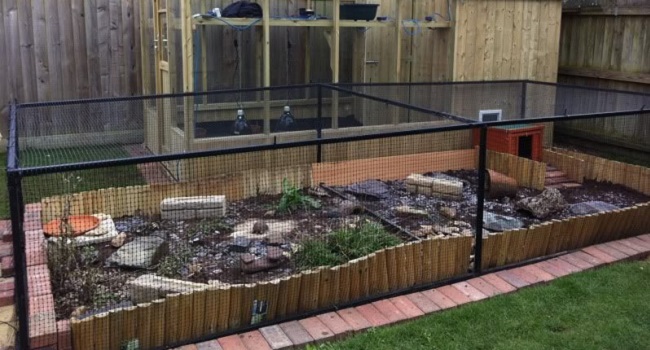
Size
Start by deciding how much space you can devote for the outdoor enclosure. If you’re creating a space that will eventually house an adult Russian tortoise, go ahead and plan for that. You can set up secure dividers to make the area smaller if needed for the baby tortoise.
The minimum outdoor enclosure size should be at least 4-foot by 4-foot. The bigger the better because once you start adding shade, hides, plants and any decorations, you begin eliminating exercise and explore space.
Walls
Once you have the space set up, decide on the materials you want to use. Simple materials like cinder blocks, bricks and wood are easy and cheap. Plus they’re hard for a baby tortoise to move… It’s actually near impossible for a 2-inch baby Russian tortoise to push a cinder block out of place.
If you choose to use wood, it may be best to use stakes to secure the base of the wall to the ground. A determined tortoise, even a small baby tortoise, will try to move things out of its way, and all the tortoise needs is a small gap to be able to escape an outdoor enclosure.
Lid
Keep the baby tortoise safe with a secure lid. Having a lid will prevent predators from taking the baby tortoise out of the enclosure. It will also help prevent a tortoise from climbing out of the enclosure.
Use hardware cloth, or chicken wire, to build a lid. Hardware cloth will weather the elements, as well as protect your tortoise. Staple the hardware cloth to a wooden frame. Add a latch or a lock to prevent determined predators from opening or removing the lid. You may need to brace the center of the lid with a strip of wood, depending on how large the enclosure is. OR you may need multiple lids to ensure the lid doesn’t collapse itself.
Underground Barrier
If you’re building the enclosure to last your tortoise through its adult-life, you’ll want to also ensure that the outdoor enclosure is dig-proof. Russian tortoises are known diggers. The easiest way to accomplish this is to burry cinder blocks in the ground. You’ll also want to use hardware cloth and create an L-shape against the cinderblock. Set the hardware cloth so that it extends at least one-foot. This will prevent the Russian tortoise from being able to dig under the cinder block.
Creating an underground barrier isn’t a HUGE concern for baby Russian tortoises, but if the enclosure is built to last the full lifespan of the Russian tortoise, you’ll want to truly create a safe outdoor enclosure for baby Russian tortoise.
Temporary Outdoor Tortoise Enclosure for Baby Tortoise
If you’re looking to create a safe outdoor enclosure for your baby Russian tortoise, but you don’t want to create a permanent enclosure, check out the pre-made habitats.
When buying a tortoise enclosure for outside, look for the following features:
- Secure lid
- No floor
- Air flow
- Sturdy design
Wooden Pet Tortoise House
Made with 100% fir wood, this outdoor enclosure is a smaller enclosure that is good for a temporary outdoor enclosure. The lid features a lock over the shade area and over the screen basking area for easy access to both sides.
Measures approximately: 26.5″L x 36.75″W x 12.5″H
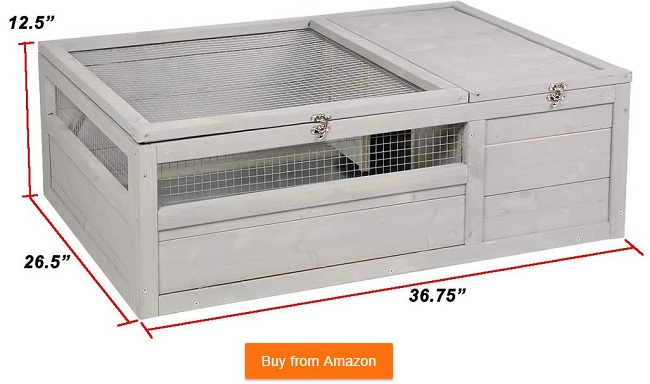
PawHut 64″ Wooden Outdoor Playpen
Perfect for rabbits and guinea pigs, but this playpen will fit a baby Russian tortoise perfectly. The outdoor habitat is made of durable weather resistant fir wood and a water-resistant composite asphalt roof.
You may need to add a sight barrier and wall to prevent a baby tortoise from squeezing out. Cut lumber to fit around the bottom of the enclosure and staple with wood staples or nail into the enclosure to prevent the wall from falling off. The barrier only needs to be about 4-inches tall.
Build a small ramp with any leftover lumber and fill the house with soil for a great outdoor tortoise habitat.
Measures approximately: 63.75″ L x 63.75″ W x 24″ H
